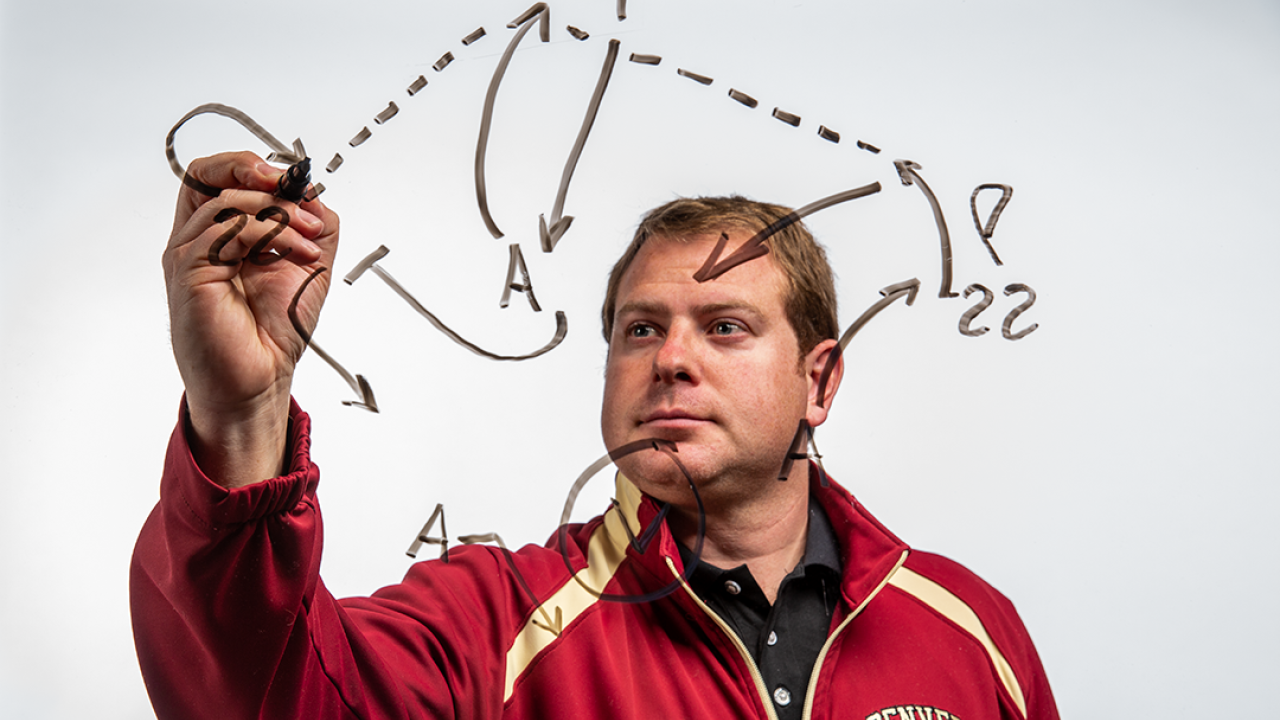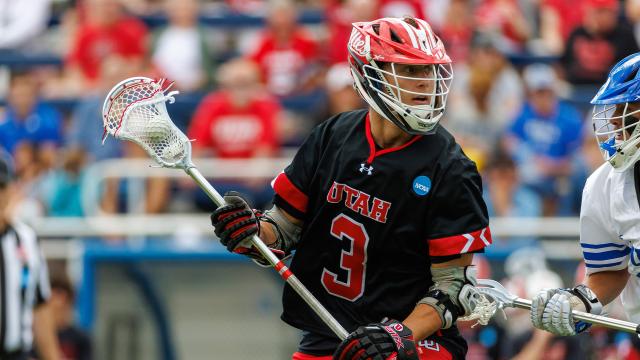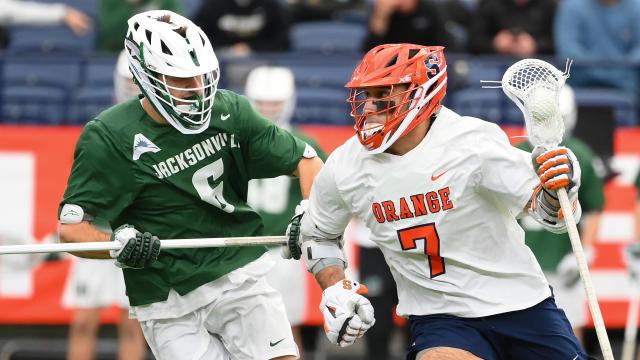
A Beautiful Mind: Inside Matt Brown's Denver Offense
This article originally appeared in the March 2015 edition of USA Lacrosse Magazine, two months before Denver won the NCAA championship.
With Hall of Fame coach Bill Tierney set to retire after this season, the school officially announced Matt Brown as his successor last week.
DENVER’S FIRST TRIP TO THE NCAA SEMIFINALS in 2011 was a wake-up call for the national lacrosse community. Former Princeton coach Bill Tierney’s Rocky Mountain project was coming along at lightning speed.
But the Pioneers’ first big voyage east was an equally enlightening experience for nearly everyone in their program, including a young offensive assistant coach, Matt Brown.
If it looked like playing in a big atmosphere, the home of the NFL’s Baltimore Ravens, was throwing off Denver’s typically well-spaced and executed offense, it was. Virginia, which went on to win the NCAA championship, led 9-2 by halftime and won 14-8. Denver’s box lacrosse-inspired two-man pick games built around Mark Matthews and Alex Demopoulos were rendered ineffective.
“We got beat up pretty bad,” Brown said.
You could almost hear the nightmares churning in his head. Brown, 31, is heralded by his peers as one of the brightest lacrosse minds around. A former Pioneers attackman, Canadian Minto Cup veteran and MLL and NLL pro, he’s now in his fifth season working under Tierney and 13th overall at Denver as a player or coach.
He’s so good, his Hall of Fame boss all but named him the next head coach at Denver, a team that has reached two more final fours and entered this season ranked No. 1 in the Nike/Lacrosse Magazine Preseason Top 20. The Pioneers are 3-0 heading into a matchup against No. 5 North Carolina on Friday.
“It’s a no-brainer,” Tierney said. “But hopefully I’m not going anywhere anytime soon. He would never say this to you, but he knows that there aren’t too many guys out there that understand it the way he does.”
What Brown understood back in May 2011 at M&T Bank Stadium in Baltimore is that Denver not only looked star-struck, but also unprepared for the noise generated by a crowd of 45,000-plus fans. Brown’s booming voice normally sent in play calls. He went unheard. So did the signals he likes to bark out during the game.
There’s a lot of what ifs in Denver’s schemes. The Pioneers read, react and make decisions quickly. Where is the slide coming from? What if it doesn’t? We forget to do things on offense. What if they forget what they’re supposed to do on defense? Why are we doing what we’re doing?
“Typically, I talk through every step,” Brown said. “It will be like I’m playing a video game in practice with these guys, understanding where to go and reads to make.”
None of Brown’s designs worked against Virginia that day. What good is the best-laid plan if the players can’t make out what it is? Denver got wiped off the field.
But just as the Pioneers offenses are known to react, adjust and appear unlike most in college lacrosse, Brown used the same innovative methodology for switching something as simple as calling in plays.
The next season, Brown created signal cards, the kind regularly seen in football but rarely in lacrosse.
There’s one white placard featuring a silhouette of the state of Minnesota, for a member of that 2011 team, Todd Baxter, who grew up there and wore jersey number 24. When Brown holds the sign up, it means get into the 2-4 formation — two attackmen behind goal-line extended, four players above.
For a 2-1-3 set, there’s a black umbrella. A diamond ring adorns another card. Man’s best friend for a play called Dog. Others simply have numbers, representing angles of attack.
And that’s just the tip of the iceberg when it comes to Denver’s offense. The Pioneers have finished no worse than sixth nationally in goals per game in each of the last four seasons. They are the only Division I men’s program to do so in that span and have reached three final fours. Brown describes the offense as a fluid document, one that includes upward of 40-50 plays and changes throughout the season, or even a game.
It’s like the Princeton offense in basketball, with an emphasis on cutting and setting picks and screens off passes. Team Canada used the same concepts at the 2014 FIL World Championship. Brown was offensive coordinator for its gold-medal run.
“He’s created an offensive system that is being emulated by a lot of different coaches in the country,” said High Point coach Jon Torpey, who coached Brown as a player his senior year at Denver in 2004 and later worked on the same coaching staff with him there.
TRUE BOX
Brown grew up in British Columbia’s lower mainland. He started out as a rink-rat ball boy who would catch outlet passes from former Burnaby Lakers goalie Curtis Pawlidor after practice. He later played in six Minto Cups, winning three Canadian national Junior A titles in the late 1990s, and enjoyed a five-year pro indoor and outdoor career.
When Brown describes his coaching philosophy, he often uses the phrase “in true box lacrosse.” Stick fakes that hold adjacent defenders. Ball movement. People movement. Creating confusion for the defense. Unselfishness. Great shots from what Brown calls “A-plus spots,” the chunk of field 10 yards wide by 12 yards long in front of the goal. Playing tight to the goal.
The philosophy reflects Brown the player, a pure inside finisher who still holds Denver’s Division I record with 113 career goals. He averaged 27 goals and just four assists in five MLL seasons with the Outlaws from 2006 to 2010.
Every Denver drill ends with a shot. The Pioneers practice shooting on a small goal inside a regulation-sized frame and are told to finish with hips toward the goal. They play basketball rules. If you miss a shot, the other team gets it, just like most every other sport. Don’t aim for the corner, hoping for a back up.
“That gives a kid a bailout,” said Tierney, who appreciates the indoor style. He played two seasons in a precursor to the NLL in 1974-75 on teams full of Canadians.
Brown’s obsession with shooting shows. The Pioneers have finished in the top 10 in shooting percentage every year since the NCAA started ranking teams nationally in 2010.
Brown bucks conventional wisdom even on basic fundamentals. For ground balls, he wishes field rules were the same as box, where you’re not allowed to take your man on a loose ball. “It gives guys excuses to not pick up a ground ball,” he said.
For alignment, Brown likes lefty attackman on the left, righties on the right and switching the plan for midfielders. “But I also think there’s a time and place for having your stick on the inside above the goal,” he said.
And those Canadian-inspired two-man schemes that came en vogue a few years ago? Overused, Brown said, even though Denver relied on them in 2011. Defenses have adapted. He also hates the term “hybrid.”
It’s all part of the stew that is the Denver offense, and an approach that Brown sold Tierney on when he arrived from Princeton in June of 2009. Brown was part of the previous coaching staff under Jamie Munro, the coach who also recruited him to Denver as a player and then hired him as an assistant. Brown flirted with a career in finance, but he gave it up after seven months.
It was no sure thing Tierney would keep Brown as part of the new regime. Tierney said the search for an assistant would take a few weeks. Brown and his wife, Jewel, plotted out possible relocation plans.
Instead, the search lasted three days.
Tierney’s son, Trevor, played with Brown on the Outlaws and was to be the team’s top assistant. He recommended Brown, who also professed his passion for the university, the place that was first to reply to him his senior year of high school when he pitched himself as a player to various U.S. programs. “It was home,” he said.
Several Denver players quit or were suspended after the 2009 season. Brown emailed the elder Tierney detailed scouting reports not only on the 12 players remaining, but also recruits and 10 others still with eligibility. The attention to detail, and a couple phone conversations, impressed the new coach.
“Matt went from looking for a job to offensive coordinator,” Tierney said. “I told him, ‘It’s your show.”
BROWNIE’S MIX
The basic ingredients of the Denver offense are not all that different from most. The four most common sets used are, counting from behind the goal, a 1-3-2, the 2-1-3 umbrella, 1-4-1 and 2-2-2. A midfielder usually initiates.
But the secret sauce comes in variation. Brown always has a whiteboard on hand. There are usually four or five motions for each set, and not all your typical three-man variety. The total number, with four other base sets and man-up looks thrown in, creates a thick menu, as Brown calls it. Senior attackman Wes Berg joked that play-call wristband that NFL quarterbacks use would be helpful.
Without giving too much away, Brown said, “If a team doesn’t want to slide and is slow to go, then you probably want to play in the middle of the field. You have a better angle to turn the corner and get your hands free. It might be more of a dodge-to-score day than a ball-movement and assisted goal day.
“Ultimately, if you stress fundamentals and then what I consider advanced skills, box skills, and decision-making, if you can understand the reads, that’s the big hurdle. Once you get over that hurdle, then everything else makes sense.”
“If a team is sliding quickly, maybe you can beat them and make them slide to an area where you’re not going to be that dangerous, but have your hands free to outlet the ball to somebody and let the ball do the work and create some really good off-ball opportunities.”
The foundation is laid in the fall with skeleton drills, half-field, 2-on-2s and 3-on-3s, and built out from there. Each week, depending on the opponent, Brown will choose plays and narrow the sets to include in the game plan, anticipating halftime adjustments.
“People can focus on doing one thing and become the best they possibly can at it. That’s a good way to do it, too. But the way I look at it is that coaching has gotten so much better and a lot more teams are much more prepared than they ever have been. You need to keep them on their toes,” Brown said. “Ultimately, if you stress fundamentals and then what I consider advanced skills, box skills, and decision-making, if you can understand the reads, that’s the big hurdle. Once you get over that hurdle, then everything else makes sense.”
Brown’s varied approach jives with the box scores Denver tends to produce. One game, Zach Miller could have six points. The next, he could have one and Jack Bobzien or Berg is the star of the day.
Watch Denver’s offense, and you will see six players moving together as if attached on a string. Given the focus on efficient shooting, possessions can last several minutes, wearing down a defense.
“We never get jumbled up. It’s always spread. It’s always balance,” Tierney said. “There’s always people in position to give the ball carrier an outlet, an open feed, and hopefully take away the slide patterns that the other team is looking to employ.”
Denver constantly alters its personnel, too. Last season, Miller and Erik Adamson switched between attack and midfield on every shift. This season could be more of the same with Connor Cannizzaro, the ACC Rookie of the Year at Maryland, in the fold. He has 10 goals and 10 assists through the Pioneers first three games.
When Brown flashes a play card, Bobzien relays the message on attack. Tyler Pace informs the midfield. Brown prefers to empower players to make their own decisions within a construct. And he gives them credit for any attention he will receive. “Players are not robots,” he said. “It’s like studying in a class. It’s all part of learning.”
Is a guy sliding to your face from the crease? Is a guy sliding to your face from the adjacent? Or is a guy doubling you from behind? Is your defender squaring up to you? Is he trying to force you to the weak hand? Or is he forcing you down the alley? And where’s he picking you up?
“Once the initial dodge happens, everyone is playing off each other,” Bobzien said. “If you dodge down the alley or over the top, other guys are reading off of you. There’s different directions and angles of attack for when you go at a guy, and you read it and go from there.”
STOCK BOY TO PIONEER
Maybe it’s because it was 4 a.m., or that the prospect of placing yet another box of pasta on the shelf had finally gotten stale. But Brown had a revelation his senior year of high school while working an early-morning weekend shift at the Safeway grocery store in Burnaby, B.C. He worked there since he was 15, three days a week. He had no college plans.
“I didn’t want to do this my whole life,” he said.
Like many Canadian boys, Brown dreamed of playing in the National Hockey League. His father, a firefighter, played soccer, so Brown did that. He played baseball, too. But Brown’s hockey friends all played lacrosse in the summer, so when he turned 11, he joined them.
“All I knew about college lacrosse was that Paul and Gary Gait went to Syracuse, and that was my dream school,” Brown said. “I grew up watching those guys every Saturday night at the Coquitlam Arena.”
At the time, U.S. colleges did not recruit Canadians like they do now. Brown sent a paragraph-long email about himself — he had just graduated from an all-boys Catholic school and played in the Minto Cup against the Orangeville Northmen — to any school he could find that had a field lacrosse program. Munro responded in less than an hour, pretty quick for the Y2K era. He got a good recommendation on Brown from Orangeville coach Lindsay Sanderson.
Three weeks later, Brown visited Denver. By then, Fairfield, Hofstra, Ohio State and a few others had also responded to Brown, but Denver won him over. He was pleasantly surprised to talk to blue-collar types with whom he could relate, like Denver associate athletic director Ron Grahame, a British Columbia native who played pro hockey in the WHA and NHL.
“It’s a different culture, growing up in Canada,” said Brown, who along with faceoff man Geoff Snider, is credited with starting the Canadian pipeline to Denver first as a player then by recruiting as a coach. “A lot more kids now go to post-secondary. At the time, if I didn’t decide to go to Denver, then I probably wouldn’t have gone to college.”
And had that not happened, Brown, and Denver, certainly wouldn’t be where they are now.
“He is Denver lacrosse,” Tierney said. “I’m not trying to diminish my input here, but Matt Brown is DU lacrosse. He’s been in it, he played it, he coaches it, he’s impassioned by it. It’s everything you could ever want in a guy being the face of the program.”
Corey McLaughlin
Related Articles




